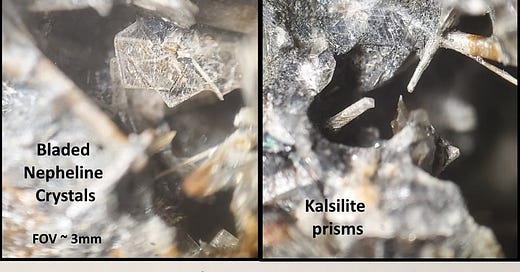“Diktytaxitic” is one of my favorite rock texture terms. It usually applies to basalt and sometimes other igneous rocks that have angular cavities into which laths of crystals, typically plagioclase feldspar, project, often in a jagged, thorny way. To my eye the rock in my photos here is a textbook example of diktytaxitic texture, but as with all such specialized jargon, your mileage may vary.
Kalsilite, whose name comes from its composition, potassium (symbol K), aluminum (Al) silicate (Si), KAlSiO4, is a feldspathoid. Feldspathoids form in rocks rather than true feldspars when there isn’t enough silica present to produce feldspars, but otherwise they are similar, albeit usually alkali-rich (sodium or potassium) like orthoclase feldspar, K(AlSi3O8), rather than like calcic plagioclase. In the photos the thicker elongate prisms are mostly kalsilite.
This specimen is from the volcanic rocks at San Venanzo, in Umbria in central Italy. The small volcano complex there erupted about 265,000 years ago (Stoppa & Sforna, 1995, Geological map of the San Venanzo volcano (Central Italy): explanatory notes: Acta Vulcanologica, 7:1, p. 85-91), initially explosively and with more quiescent lava flows toward the end. Other than ash falls, the volcanic rocks are carbonatites (essentially molten calcite, calcium carbonate) and ultra-alkalic rocks, so the kalsilite is not a surprise. Carbon dioxide in the magmas made for the initial explosivity, perhaps combined with the eruption coming through a lake that was present at the time. And the presence of such volatiles probably helped generate the large volumes of cavities in the rocks even when the lava flowed more quietly.

The ultimate tectonic story that made this happen is really complicated. What is now the Italian Peninsula was probably a narrow terrane of crust either off the coast of Anatolia (today’s Turkey) or further west along the north coast of Gondwana (Africa). It was pushed around in the overall collision between Africa and Europe (and it is still being pushed today), with one consequence being a general shove to the northeast (present-day coordinates) over the Adriatic Plate, an elongate, low, thin-crust terrane (but probably not fully oceanic). That push raised up the initial Apennine range along the spine of Italy about 25 million years ago.
Around 14 million years ago, the Apennine block began to rotate as a consequence of the opening of ocean basins in the western Mediterranean, today’s Ligurian Sea and the regions west of Corsica and Sardinia. The crust continued to stretch, and around 6 million years ago the Tyrrhenian Sea basin began to form, which gave the Apennines and the Italian Peninsula a further push and rotation. With all that complexity, additional extension related to the Tyrrhenian Sea, mostly more recent than 3 million years ago, began to break the Peninsula into long normal faults, which was the proximal cause of the volcanism in Umbria, at San Venanzo.
At least that’s a first approximation of the tectonic story.
Above: Paleogeographic reconstruction of the San Venanzo volcano several hundred years after the eruption 265,000 years ago. 1 = San Venanzo maar; 2 = Pian di Celle tuff-ring; 3 = Celli lapilli cone. Drawn by A. Speziale; from Stoppa & Sforna, 1995, cited above; annotations added. A maar is a relatively small volcanic crater that results from the explosive interaction of magma and groundwater; tuff is solidified volcanic ash; and lapilli are small fragments of rock or lava that solidify as they fall through the air, often with accretion around raindrops and defined as in a size range from 2 to 64 mm.
In addition to the elongate white prisms of kalsilite, this rock has tiny needles that are almost certainly an unusual habit of fluorapatite (calcium phosphate-fluoride), some magnetite (iron oxide), and possibly some brown blades of fluorophlogopite, a potassium-magnesium mica with fluorine. There are also bladed crystals of nepheline (another feldspathoid) and brown forsterite (magnesium silicate). It’s a weird rock. Cat. No. 916.
The word diktytaxitic was coined by Richard E. Fuller, with the advice of Dr. Charles E. Weaver and Professor G. F. Goodspeed (Fuller, R.E., 1931, The geomorphology and volcanic sequence of Steens Mountain in southeastern Oregon: University of Washington Publications in Geology, v.3, no. 1, p. 116; based on Fuller’s Ph.D. dissertation), from Greek diktuon, a net, and taxis, arrangement. Fuller (1897-1976) was a professor at the University of Washington and worked extensively on the Steens Basalt among many other subjects. He was the unpaid president and director of the Seattle Art Museum for 40 years; his family donated $250,000 for the museum to construct a building during the depths of the Depression in 1932-1933.






Lapilli forming around raindrops, lovely image, I didn't know that one
Yes, a very weird rock